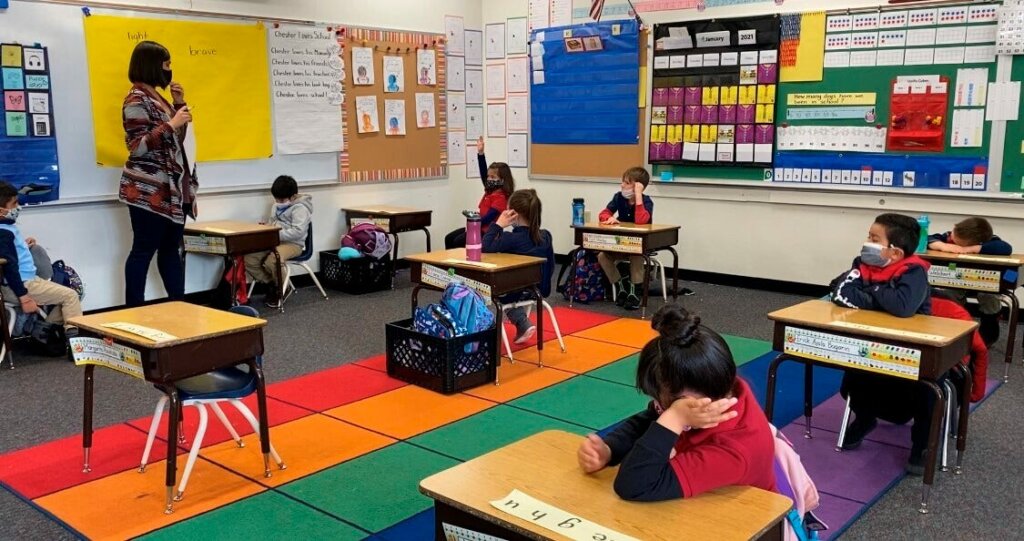| Key takeaways for coping with teacher burnout: 1. Teacher burnout is at an all-time high. Listen to teachers and implement their suggestions—they know the classroom best. 2. Addressing teacher mental health through workshops and seminars is not enough. Use more concrete measures, like built-in days off, to lessen teachers' workloads.3. Provide sufficient resources in the classroom and, if possible, address teacher shortages. 4. Use social-emotional strategies and prioritize inclusion to boost teacher satisfaction and health. |
These days, teachers need more support than ever to make it through the school year. As educators tackle ongoing struggles on the heels of the pandemic, like students' behavioral issues and shortened attention spans, teacher burnout continues to rise. According to a 2022 Gallup poll, K–12 teachers are the #1 most burnt-out occupation in America. That's a lot of burnout! Many teachers are leaving careers that they love due to feeling overwhelmed, undervalued, and unable to cope with increased workloads. One Rand study found that teachers—especially teachers of color—experience job-related stress at double the rate of other workers. Although teachers are essential, too often, they're made to feel like they're on their own.
Listening Is Only the First Step
Providing teachers with the best support starts with listening. Teachers receive advice from all sorts of sources—from administrators to parents to their own families and friends. It's undoubtedly frustrating to hear conflicting, uninformed perspectives from those without experience in the classroom. Instead, the first step to supporting classroom teachers is actively listening. Letting teachers share and showing empathy can help them feel understood—though it's essential to take the next step to actually address their concerns.
Starting with sharing.
To cultivate an open environment for sharing, administrators should encourage discussions among faculty members. Educators often encounter similar challenges, even across grade levels or subjects, and sharing these challenges cultivates a sense of community. Plus, collaborative brainstorming might solve some of the more pressing issues. Teachers can also find helpful suggestions in professional learning networks, though the time investment required to participate in a PLN may eat into class prep time. No matter where they interact—social media, PLNs, or passing in the hallway—communities of support are essential for teachers' well-being.
As important as it is for teachers to support one another, that's not enough to carry them through the many obstacles they confront during the school year. The academic, social, and emotional effects of the pandemic continue to impact education, and it's natural for educators to feel discouraged. Do my efforts matter? Do I truly belong in the classroom? Will I make it through the rest of the week? Administrators may be prone to these feelings as well—balancing the many concerns of leaders, teachers, and parents is not an easy task. And, as new innovations like artificial intelligence change the shape of learning, classroom practices need to adapt as well. Navigating these developments is challenging, and classroom environments have certainly shifted in the past couple of years. As the people who spend the most time in the classroom, teachers feel they should have a voice.
Letting teachers use what they know.
Giving teachers a chance to share their concerns is helpful, but including them in decision-making is even better. Although addressing everyone's opinions regarding educational policies is all but impossible, it's important for administrators to be upfront with faculty members. Teachers should never feel blindsided by new policies—especially when it comes to instruction. Safety and logistical preferences may be out of their hands, but when it comes to academics, nobody knows better than teachers.
Involving teachers in significant schoolwide decisions can take many forms. Faculty meetings present a natural opportunity for them to raise ideas, questions, and challenges, but there are plenty of other ways to create an environment in which educators have a say. Forming committees focused on specific topics, such as curriculum or school culture, allows teachers and administrators to come together to spark change. Administrators can also distribute surveys for a wider range of opinions, or implement an open-door policy. Such policies encourage teachers to safely share concerns and ideas and contribute to a welcoming environment throughout the school.

Working through Teacher Burnout
During remote learning, teachers were at the forefront of some of the most drastic shifts in daily life. Now, back in the classroom, many teachers are facing new levels of burnout. Few people outside of the education community understand all that educators have overcome in the past several years. Support measures like "wellness programs and mindfulness activities" feel hollow and can even contribute to stress by adding more tasks to teachers' to-do lists. More tangible efforts are needed to reduce teacher burnout, according to Doris Santoro, a professor of education at Bowdoin College in Maine. Rather than empty reinforcement, teachers need authentic, long-lasting systems of support.
Offering sufficient mental health resources.
Over 50% of teachers report feeling the effects of teacher burnout or experiencing increased anxiety due to their job. When it comes to feelings of stress, however, the number jumps to almost 65%. And because of teacher shortages, educators have more on their plates than ever. Beyond robust community and active listening, educators need everything from counseling services to built-in days off to recharge. To reduce stress, school leaders should avoid new policies and programs and instead look into extending mental health services. Rand reported that only about one-third of teachers had access to counseling, and of that number, many felt that the support was substandard and time-consuming. Improving mental health supports can alleviate, if not completely solve, many of the difficulties today's teachers face.
Teachers Still Worry About More than Themselves
Besides their own mental health concerns, educators also worry about the mental, social, and emotional health of their students. Despite increased awareness of social-emotional wellness during the past several years, mental health counselors are far from ubiquitous. Not only is this a missed opportunity to give students much-needed guidance, it also means teachers must take on yet another role. Teachers aren't trained to help children through the death of a family member, concerns about school security, or other fears. Yet too often, teachers find themselves in the role of counselor regarding these issues.
Extra responsibilities contribute to teacher burnout.
Beyond mental health, teachers have also had to shoulder responsibilities created by lack of resources. In 2022, 44% of public schools posted teaching jobs—meaning teacher shortages affect nearly half of public schools nationwide. Due to these staffing shortages, two-thirds of teachers had to take on additional classes and students, according to the Rand study mentioned above. Teacher shortages create frustration and helplessness among teachers who are overwhelmed by inflated workloads. Classroom learning suffers as well, as students demand more energy from already exhausted teachers.
Teachers have a long list of concerns.
Beyond mental and physical health, educators also worry about the effects of technology and the content they teach. After a period of remote learning, some students struggle to give up their ties to distracting technology. Others have difficulty adjusting to screen-free interactions. Still others subvert learning outcomes by relying on ChatGPT. Meanwhile, teachers face the difficulty of balancing their personal views with state policies. They might be expected to discuss social justice issues, or, conversely, they might be forbidden from addressing certain social topics. While finances and burnout are major issues, teachers' worries extend far beyond.

Fostering Ongoing Support for Teachers
We've painted a bleak picture of the current education environment. Teachers are burnt out and discouraged, and school leaders struggle to satisfy everyone. However, that doesn't mean teaching is a lost profession. The support teachers need is shifting, but by working together, we can change the shape of education for the better. What does this shift look like? Ensuring an effective distribution of resources is one major step to improving teacher satisfaction. But new resources won't help all teachers and students if the school environment is not inclusive and equitable. That's why true change in schools starts from the ground up: listening to the voices of teachers themselves is the best way to know what they need.
Prioritize financial resources.
As social media movements like #ClearTheList indicate, educators struggle to get the necessary resources to be effective in the classroom. Beyond the emotional boon of collaborating with peers and influencing their administrators, teachers also need financial and material support. The Teacher Salary Project reports that 74% of teachers "believe that their salary is not fair for the work they do," and many cite lack of compensation as their reason for leaving the profession. Providing fair compensation is therefore one of the most significant ways to alleviate teacher burnout. In fact, two-thirds of teachers say that raising salaries is the best way to "attract and retain a talented and diverse workforce." Although many factors contribute to teacher burnout, the stress of being overworked and undervalued is a driving factor in lack of retention among educators.
Along with better compensation, additional financial support could come in the form of resources such as new classroom supplies, updated technology, and professional development opportunities. Such support could sponsor the $500 to $750 that educators spend annually on school supplies—usually from their own salaries. More in-depth financial incentives may include bonuses, tuition reimbursement, and even housing subsidies. By investing in teachers, we invest in the futures of our students and our communities. Providing financial support to teachers helps reduce burnout and turnover rates, which ultimately benefits both educators and their students. It is crucial that we prioritize the needs of teachers in order to create a successful and sustainable education system.
Create a truly inclusive environment.
The financial barriers and negative work environments we have discussed so far are augmented among educators of color, who face even more obstacles. In one Teacher Salary Project survey, 62% of educators of color were currently working multiple jobs to make ends meet, as opposed to 53% of all teachers. Although it is saddening that any teacher would need to supplement their income, teachers of color have more of a disadvantage, according to the data. Teachers of color were also more likely to report symptoms of depression. This sobering reality is amplified by the fact that over one-third of teachers of color have experienced racial discrimination at school, according to the 2022 Rand report. These struggles likely contribute to teachers of color leaving the profession "at higher rates than their White colleagues," depriving students of these teachers' talent and mentorship.
"Teachers and principals of color were two to three times more likely to report experiencing racial discrimination than their White peers." (Rand, 2022)
In order to foster an inclusive environment, school leaders must not only seek input from educators of color but also provide them with the resources to thrive in the classroom. One essential step is to remove extra "identity-based labor" from teachers of color. Black and Latinx educators are often tasked to specially mentor students of color who act out. Instead, leaders should consider the school-wide systems needed to support these students holistically. For example, nearly 60% of kids who qualify for free school meals are students of color. Food insecurity may cause some students to misbehave, and appointing teachers of color as mentors assigns them the unfair responsibility of attempting to solve a larger issue through individual relationships. When supporting these teachers, school leaders should make it clear that teacher input is not only welcomed but actively sought out—then make tangible changes based on the feedback.
Teachers are changemakers.
Twitter (X) user Rachael Mann put it this way: "Every time someone tells me about a teacher that has made an impact on their life, I ask them, 'Do they know?' or 'Have you told them?' and usually the answer is no. Teachers never fully know the impact that they have made on the lives that they have touched." Despite the many struggles that come with working in education, teachers can change the lives of an entire generation. Yes, teaching is exhausting, difficult, and at times thankless—but it doesn't have to be this way. When teachers' voices are heard and valued, schools can make changes to lessen teacher burnout.
Prioritizing teachers is working well for one middle school in Aurora, Colorado. To address teacher burnout and low student scores, school leaders created an intentional collaborative time for teachers during the week. Their class schedule rotates in such a way that core teachers get one uninterrupted school day for lesson planning, reducing their after-hours workload. While students broaden their horizons in electives, teachers get to plan, work together, and solve problems. Teachers have reported feeling more freedom when "planning isn't cut off by a bell," and students enjoy having more flexible class offerings. As education continues to adapt to the changing world, we hope to see more schools considering their teachers' needs.
For the latest EdTech, STEM, and 21st century education news, follow us on Twitter and Instagram. Like us on Facebook, too, or sign up for our newsletter for our latest product announcements and offerings. If you have an idea for an Eduporium Weekly theme, send us a message on social media or comment below.



